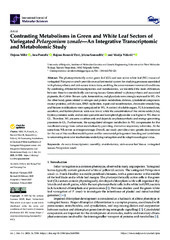Приказ основних података о документу
Contrasting Metabolisms in Green and White Leaf Sectors of Variegated Pelargonium zonale—An Integrative Transcriptomic and Metabolomic Study
| dc.creator | Milić, Dejana | |
| dc.creator | Pantelić, Ana | |
| dc.creator | Banović Đeri, Bojana | |
| dc.creator | Samardžić, Jelena | |
| dc.creator | Vidović, Marija | |
| dc.date.accessioned | 2023-03-22T11:39:18Z | |
| dc.date.available | 2023-03-22T11:39:18Z | |
| dc.date.issued | 2023 | |
| dc.identifier.issn | 1422-0067 | |
| dc.identifier.uri | https://www.mdpi.com/1422-0067/24/6/5288 | |
| dc.identifier.uri | https://imagine.imgge.bg.ac.rs/handle/123456789/1795 | |
| dc.description.abstract | The photosynthetically active green leaf (GL) and non-active white leaf (WL) tissues of variegated Pelargonium zonale provide an excellent model system for studying processes associated with photosynthesis and sink-source interactions, enabling the same microenvironmental conditions. By combining differential transcriptomics and metabolomics, we identified the main differences between these two metabolically contrasting tissues. Genes related to photosynthesis and associated pigments, the Calvin–Benson cycle, fermentation, and glycolysis were strongly repressed in WL. On the other hand, genes related to nitrogen and protein metabolism, defence, cytoskeletal components (motor proteins), cell division, DNA replication, repair and recombination, chromatin remodelling, and histone modifications were upregulated in WL. A content of soluble sugars, TCA intermediates, ascorbate, and hydroxybenzoic acids was lower, while the concentration of free amino acids (AAs), hydroxycinnamic acids, and several quercetin and kaempferol glycosides was higher in WL than in GL. Therefore, WL presents a carbon sink and depends on photosynthetic and energy-generating processes in GL. Furthermore, the upregulated nitrogen metabolism in WL compensates for the insufficient energy from carbon metabolism by providing alternative respiratory substrates. At the same time, WL serves as nitrogen storage. Overall, our study provides a new genetic data resource for the use of this excellent model system and for ornamental pelargonium breeding and contributes to uncovering molecular mechanisms underlying variegation and its adaptive ecological value. | |
| dc.language | en | |
| dc.relation | info:eu-repo/grantAgreement/MESTD/inst-2020/200042/RS// | |
| dc.relation | Bilateral projects (no. 451-03-01963/2017-09/09 and VARIEGOMICS). | |
| dc.rights | openAccess | |
| dc.rights.uri | https://creativecommons.org/licenses/by/4.0/ | |
| dc.source | International Journal of Molecular Sciences | |
| dc.source | International Journal of Molecular Sciences | |
| dc.subject | Pelargonium zonale | |
| dc.subject | de novo transcriptomic assembly | |
| dc.subject | metabolomics | |
| dc.subject | sink-source leaf tissue | |
| dc.subject | variegated leaves | |
| dc.title | Contrasting Metabolisms in Green and White Leaf Sectors of Variegated Pelargonium zonale—An Integrative Transcriptomic and Metabolomic Study | |
| dc.type | article | en |
| dc.rights.license | BY | |
| dc.citation.issue | 6 | |
| dc.citation.rank | M21~ | |
| dc.citation.spage | 5288 | |
| dc.citation.volume | 24 | |
| dc.identifier.doi | 10.3390/ijms24065288 | |
| dc.identifier.fulltext | https://imagine.imgge.bg.ac.rs/bitstream/id/125937/Contrasting_Metabolisms_in_Green_and_White_Leaf_Sectors_of_Variegated_Pelargonium_zonale_An_Integrative_Transcriptomic_and_Metabolomic_Study_2023.pdf | |
| dc.type.version | publishedVersion |

